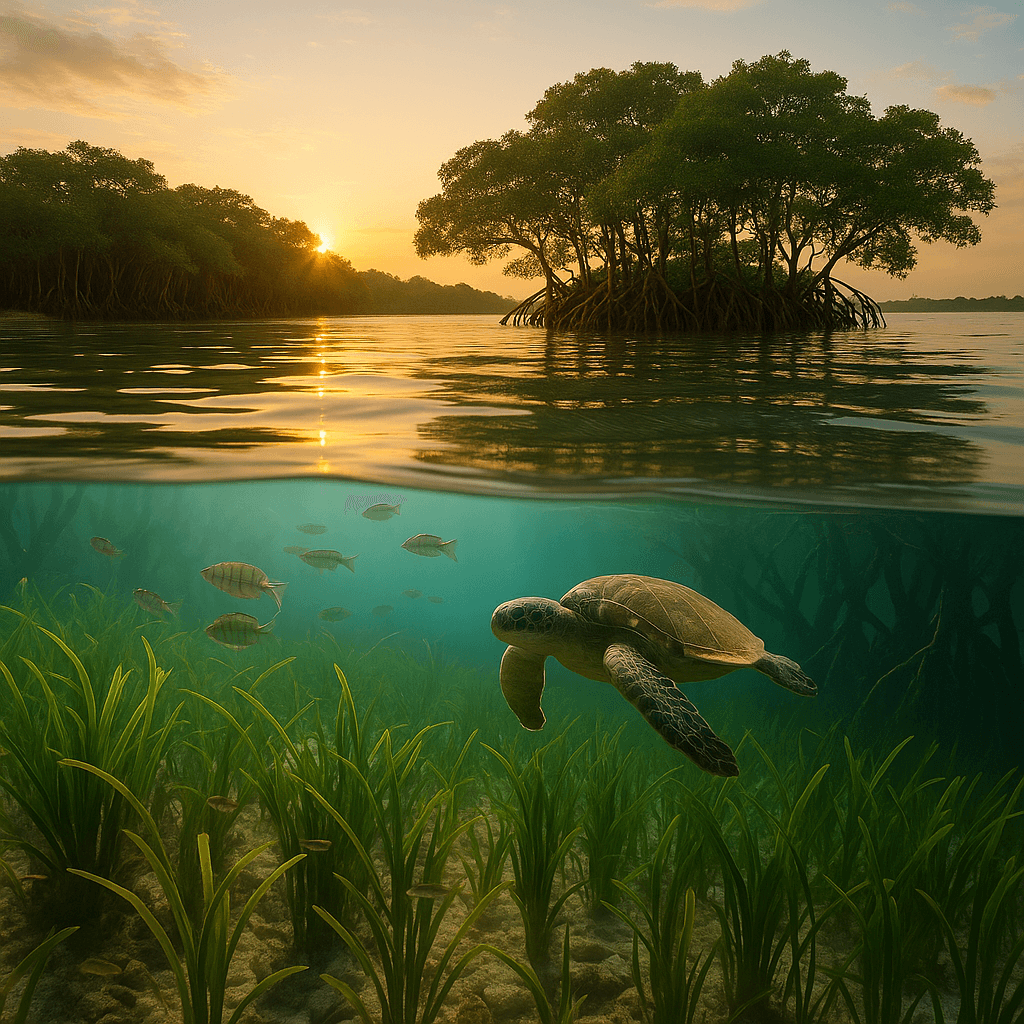Why Blue Carbon Ecosystems Like Mangroves Could Be the Most Powerful Climate Solution We’re Overlooking

You’ve paid to plant trees. You’ve heard about saving the rainforest.
But while the world praises the Amazon, mangroves, seagrass, and salt marshes quietly keep pulling carbon from the air — 10x faster than forests.
So why does ocean-based climate action still feel invisible?
1. The Assumption That Needs Breaking
We’ve been sold a simple idea:
Carbon lives in trees. The best solution is planting more of them.
But what if that’s only part of the truth?
What if some of the most powerful, permanent carbon sinks aren’t green and leafy — but blue and tidal?
We glorify rainforest offsets while coastlines drown. That’s a problem.
2. The Everyday Disconnect
Think about the last time you offset something — maybe a flight or a monthly footprint.
Did you picture a lush forest? A planted tree? A carbon label on a product?
Probably not a muddy mangrove. Or an underwater grassland.
And definitely not something growing in saltwater.
Blue carbon doesn’t feel like a solution — because it hasn’t been marketed as one.
But it should be.
3. What Blue Carbon Really Does (And Why It Matters)
Let’s break it down. Here’s what coastal ecosystems are quietly doing for the planet — and why they might be your offset’s best-kept secret:
1. They store carbon faster — and deeper.
Mangroves and seagrasses sequester carbon at up to 10x the rate of terrestrial forests, mostly in the soil, where it can stay for centuries.
2. They protect people.
These ecosystems naturally shield communities from storm surges, erosion, and rising seas — providing real climate adaptation.
3. They feed the world.
Coastal wetlands are breeding grounds for fish and support millions of livelihoods globally.
But here’s the twist: when destroyed, these areas release massive amounts of carbon — undoing centuries of storage.
Quick Facts:
- Mangrove deforestation alone emits 10% of global deforestation emissions, despite covering just 0.7% of tropical forest area.
- Over the last 50 years, we’ve lost up to 50% of the world’s mangroves.
- When destroyed, just one hectare of mangrove can release up to 1,000 metric tons of carbon, often more than a tropical forest of the same size.
- Blue carbon ecosystems cover less than 2% of Earth’s surface but hold more than 50% of its biological carbon.
- And yet, they receive just a fraction of global carbon funding.
4. Why Blue Carbon Gets Overlooked
Let’s be honest:
Oceans are complicated.
Land-based offsets are easier to measure, claim, and resell.
A tree comes with a certificate.
A seagrass meadow? Not so much.
It’s not that blue carbon isn’t effective — it’s that it doesn’t fit neatly into today’s carbon markets.
But isn’t that exactly the kind of climate blind spot we should be questioning?
5. Cost, Trust, and Long-Term Impact
Blue carbon isn’t always the cheapest solution — but it’s one of the most co-benefit-rich.
- You’re not just capturing CO₂.
- You’re protecting shorelines, fisheries, biodiversity, and communities.
- You’re funding work that lasts, even when the camera crews go home.
At CleanCents, we believe that’s what real climate action should look like.
6. Challenge + Reader Activation
Let’s ask the real question:
If mangroves pull more carbon, protect more people, and deliver longer-term impact…
Why do we still treat trees like the gold standard?
Would you fund a muddy wetland instead of a glossy rainforest?
Do you care more about visibility — or verifiable impact?
Tell us. Debate it. Challenge us.
This is the conversation we need to have.
7. Because You Care, We Go Deeper
If you’ve ever paid to remove your footprint, you deserve to know what you’re actually funding — and what’s being left out.
Read the full breakdown:
When You Pay to Remove Carbon, What Are You Actually Getting?
Because you care, coastlines matter.
Let’s make blue carbon visible, fundable, and unstoppable.